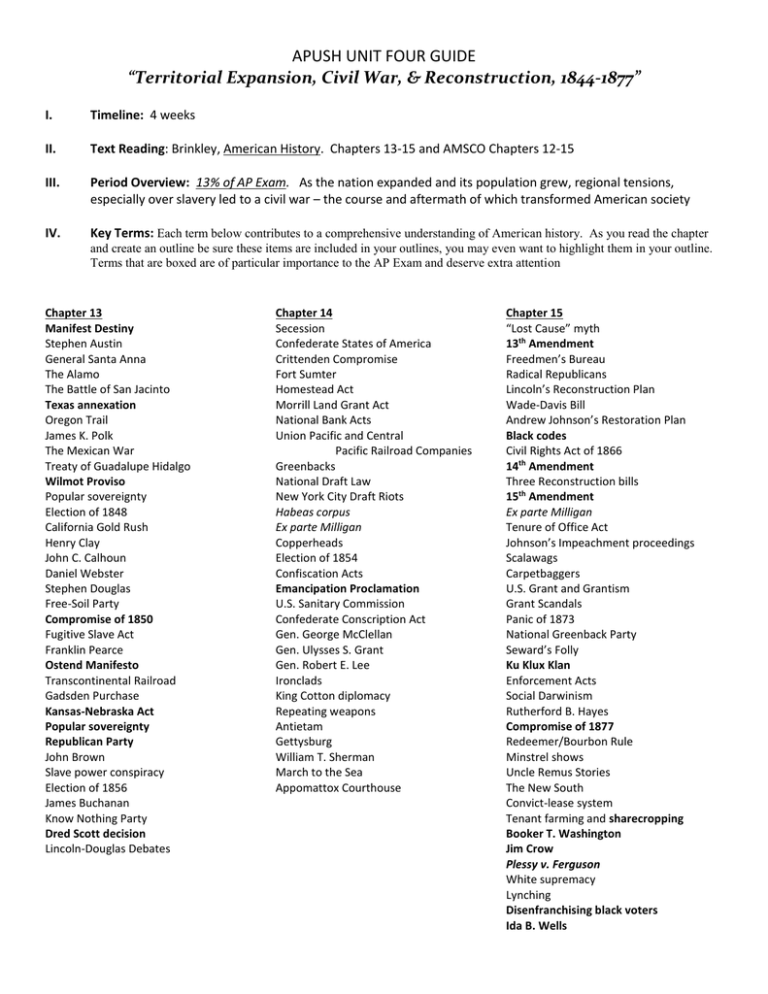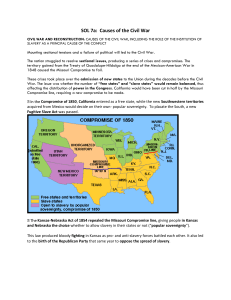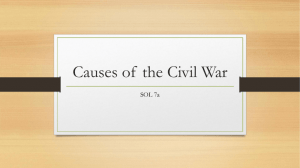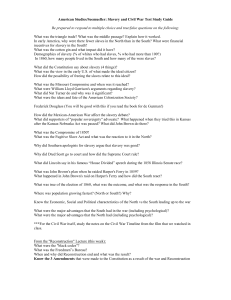Territorial Expansion, Civil War, & Reconstruction, 1844-1877
advertisement

APUSH UNIT FOUR GUIDE “Territorial Expansion, Civil War, & Reconstruction, 1844-1877” I. Timeline: 4 weeks II. Text Reading: Brinkley, American History. Chapters 13-15 and AMSCO Chapters 12-15 III. Period Overview: 13% of AP Exam. As the nation expanded and its population grew, regional tensions, especially over slavery led to a civil war – the course and aftermath of which transformed American society IV. Key Terms: Each term below contributes to a comprehensive understanding of American history. As you read the chapter and create an outline be sure these items are included in your outlines, you may even want to highlight them in your outline. Terms that are boxed are of particular importance to the AP Exam and deserve extra attention Chapter 13 Manifest Destiny Stephen Austin General Santa Anna The Alamo The Battle of San Jacinto Texas annexation Oregon Trail James K. Polk The Mexican War Treaty of Guadalupe Hidalgo Wilmot Proviso Popular sovereignty Election of 1848 California Gold Rush Henry Clay John C. Calhoun Daniel Webster Stephen Douglas Free-Soil Party Compromise of 1850 Fugitive Slave Act Franklin Pearce Ostend Manifesto Transcontinental Railroad Gadsden Purchase Kansas-Nebraska Act Popular sovereignty Republican Party John Brown Slave power conspiracy Election of 1856 James Buchanan Know Nothing Party Dred Scott decision Lincoln-Douglas Debates Chapter 14 Secession Confederate States of America Crittenden Compromise Fort Sumter Homestead Act Morrill Land Grant Act National Bank Acts Union Pacific and Central Pacific Railroad Companies Greenbacks National Draft Law New York City Draft Riots Habeas corpus Ex parte Milligan Copperheads Election of 1854 Confiscation Acts Emancipation Proclamation U.S. Sanitary Commission Confederate Conscription Act Gen. George McClellan Gen. Ulysses S. Grant Gen. Robert E. Lee Ironclads King Cotton diplomacy Repeating weapons Antietam Gettysburg William T. Sherman March to the Sea Appomattox Courthouse Chapter 15 “Lost Cause” myth 13th Amendment Freedmen’s Bureau Radical Republicans Lincoln’s Reconstruction Plan Wade-Davis Bill Andrew Johnson’s Restoration Plan Black codes Civil Rights Act of 1866 14th Amendment Three Reconstruction bills 15th Amendment Ex parte Milligan Tenure of Office Act Johnson’s Impeachment proceedings Scalawags Carpetbaggers U.S. Grant and Grantism Grant Scandals Panic of 1873 National Greenback Party Seward’s Folly Ku Klux Klan Enforcement Acts Social Darwinism Rutherford B. Hayes Compromise of 1877 Redeemer/Bourbon Rule Minstrel shows Uncle Remus Stories The New South Convict-lease system Tenant farming and sharecropping Booker T. Washington Jim Crow Plessy v. Ferguson White supremacy Lynching Disenfranchising black voters Ida B. Wells Concept Outline for Historical Period 5: 1844-1877 Key Concept 5.1: The United States became more connected with the world as it pursued an expansionist foreign policy in the Western Hemisphere and emerged as the destination for many migrants from other countries I. Enthusiasm for U.S. territorial expansion, fueled by economic and national security interests and supported by claims of U.S. racial and cultural superiority, resulted in war, the opening of new markets, acquisition of new territory, and increased ideological conflicts a. The idea of Manifest Destiny, which asserted U.S. power in the Western Hemisphere and supported U.S. expansion westward, was built on a belief in white racial superiority and a sense of American cultural superiority, and helped to shape the era’s political debates b. The acquisition of new territory in the West and the U.S. victory in the Mexican-American War were accompanied by a heated controversy over allowing or forbidding slavery in the newly acquired territories c. The desire for access to western resources led to the environmental transformation of the region, new economic activities, and increased settlement in areas forcibly taken from American Indians d. U.S. interest in expanding trade led to economic, diplomatic, and cultural initiatives westward to Asia (SPECIFIC EXAMPLES: clipper ships, Commodore Perry’s expedition to Japan, missionaries) II. Westward expansion, migration to and within the U.S., and the end of slavery reshaped North American boundaries and caused conflicts over American cultural identities, citizenship, and the question of extending and protecting rights for various groups of U.S. inhabitants a. Substantial numbers of new international migrants – who often lived in ethnic communities and retained their religion, language, and customs – entered the country prior to the Civil War, giving rise to a major, often violent nativist movement that was strongly anti-Catholic and aimed at limiting immigrants’ cultural influence and political and economic power (SPECIFIC EXAMPLES: parochial schools, Know-Nothings) b. Asian, African American, and white peoples sought new economic opportunities or religious refuge in the West, efforts that were boosted during and after the Civil War with the passage of new legislation promoting national economic development (SPECIFIC EXAMPLE: Mormons, gold rush, Homestead Act) c. As the territorial boundaries of the U.S. expanded and the migrant population increased, U.S. government interaction and conflict with Hispanic and American Indians increased, altering these groups’ cultures and ways of life and raising questions about their status and legal rights (SPECIFIC EXAMPLE: Sand Creek Massacre, Little Big Horn) KEY CONCEPT 5.2: Intensified by expansion and deepening regional divisions, debates over slavery and other economic, cultural, and political issues led the nation into civil war. I. The institution of slavery and its attendant ideological debates, along with regional economic and demographic changes, territorial expansion in the 1840s and 1850s, and cultural differences between North and the South, all intensified sectionalism a. The North’s expanding economy and its increasing reliance on a free-labor manufacturing economy contrasted with the South’s dependence on an economic system characterized by slave-based agriculture and slow population growth b. Abolitionists, although a minority in the North, mounted a highly visible campaign against slavery, adopting strategies of resistance ranging from fierce arguments against the institution and assistance in helping slaves escape to willingness to use violence to achieve their goals c. States’ rights, nullification, an racist stereotyping provided the foundation for the Southern defense of slavery as a positive good II. Repeated attempts at political compromise failed to calm tensions over slavery and often made sectional tensions worse, breaking down the trust between sectional leaders and culminating in the bitter election of 1860, followed by the secession of southern states a. National leaders made a variety of proposals to resolve the issue of slavery in the territories, including the Compromise of 1850, the Kansas-Nebraska Act, and the Dred Scott decision, but these ultimately failed to reduce sectional conflict b. c. The 2nd party system ended when the issues of slavery and anti-immigrant nativism weakened loyalties to the two major parties and fostered the emergence of sectional parties, most notably the Republican Party in the North and the Midwest Lincoln’s election on a free soil platform in the election of 1860 led various Southern leaders to conclude that their states must secede from the Union, precipitating civil war KEY CONCEPT 5.3: The Union victory in the Civil War and the contested Reconstruction of the South settled the issues of slavery and secession, but left unresolved many questions about the power of the federal government and citizenship rights I. The North’s greater manpower and industrial resources, its leadership, and the decision for emancipation eventually led to the Union military victory over the Confederacy in the devastating Civil War a. Both the Union and the Confederacy mobilized their economies and societies to wage the war even while facing considerable home front opposition b. Lincoln’s decision to issue the Emancipation Proclamation changed the purpose of the war, enabling many African Americans to fight in the Union Army and helping prevent the Confederacy from gaining full diplomatic support from European powers c. Although Confederate leadership showed initiative and daring early in the war, the Union ultimately succeeded due to improved military leadership, more effective strategies, key victories, greater resources, and the wartime destruction of the South’s environment and infrastructure (SPECIFIC EXAMPLES: Gettysburg, Sherman’s March to the Sea) II. The Civil War and Reconstruction altered power relationships between the states and the federal government and among the executive, legislative, and judicial branches, ending slavery and the notion of a divisible union but leaving unresolved questions of relative power and largely unchanged social and economic patterns a. The 13th Amendment abolished slavery, bringing about the war’s most dramatic social and economic change, but the exploitative and soil-intensive sharecropping system endured for several generations b. Efforts by radical and moderate Republicans to reconstruct the defeated South changed the balance of power between Congress and the presidency yielding some short-term successes, reuniting the union, opening up political opportunities and other leadership roles to former slaves, and temporarily rearranging the relationships between white and black people in the South (SPECIFIC EXAMPLES: Hiram Revels, Blanche K. Bruce, Robert Smalls) c. Radical Republicans’ efforts to change southern racial attitudes and culture and establish a base for their party in the South ultimately failed due both to determined southern resistance and to the North’s waning resolve III. The constitutional changes of the Reconstruction period embodied a Northern idea of American identity and national purpose and led to conflicts over new definitions of citizenship, particularly regarding the rights of African Americans, women, and other minorities a. Although citizenship, equal protection of the laws, and voting rights were granted to African Americans in the 14 th and 15th Amendments, these rights were progressively stripped away through segregation, violence, Supreme Court decisions, and local political tactics b. The women’s rights movement was both emboldened and divided over the 14th and 15th Amendments to the Constitution c. The Civil War Amendments established judicial principles that were stalled for many decades but eventually became the basis for court decisions upholding civil rights



